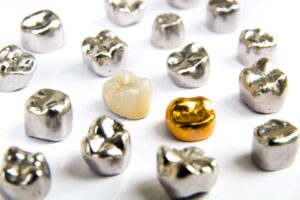
Throughout history, people have struggled to maintain happy, healthy teeth. Without access to regular oral care, issues that can be treated today may have meant extraction in the past. Thankfully, ongoing advancements in dental tools and technology have resulted in solutions that are both beautiful and practical to avoid this scenario.
For example, if you’ve recently undergone a root canal or have an overly injured or decayed tooth, there’s a good chance your dentist will protect it with a dental crown after completing the necessary repairs. These tooth-shaped caps are made of durable materials that can last 20+ years and are customized to match your grin. Today, your dentist can use this method to preserve your natural teeth to maintain optimal oral health instead of removing and replacing them.
Keep reading to learn more about how dental crowns have developed over time to become the tried-and-true method to safeguard your smile!
Early Origins
According to the American Dental Association, humans have struggled with dental health as long as we’ve existed. The earliest history of dentistry dates back to a Sumerian text from 5000 B.C. that discusses “tooth worms” as the cause of cavities. However, we don’t have a written record of dental crowns until around 166 to 201 A.D. At that time, Etruscans began experimenting with creating them out of gold.
That said, these were not necessarily intended to be functional repairs. Gold was only accessible to those who could afford it, and so these golden teeth were made to replace the healthy teeth of high-status, wealthy people. These initial attempts were fragile and couldn’t be used to bite or chew hard or coarse foods, so they were considered a cosmetic enhancement.
Middle Ages Advancements
Many experts consider dentistry as we know it to have originated in the Middle Ages. Sometime between the 1200s and 1300s in France, a Guild of Barbers was established. It consisted of both surgeons and lay barbers, who were responsible for various hygienic, aesthetic, and dental services, including tooth extractions.
In the 1500s, Europe continued to see additional upgrades in the field. In 1530, the book “The Little Medicinal Book for all Kinds of Infirmities of the Teeth” included basic procedures like drilling and filling teeth and creating dental crowns.
Ongoing Upgrades
Dental tools, technology, and techniques continued to evolve over the next few centuries. In the 1700s, a Parisian dentist named Claude Mouton pioneered the development of functional gold dental crowns. He published a book containing his works, which paved the way for further progression.
In the 1800s, Dr. Charles H. Land patented a porcelain “jacket” crown that could be used to cover a broken tooth. However, it was prone to cracking itself and often injured neighboring teeth and gum tissue.
Finally, in the 20th century, porcelain was fused with metal to create durable dental crowns that looked more lifelike. In 1984, the first synthetic restoration created entirely of ceramics and glass was manufactured and quickly gained popularity from both dentists and their patients.
Today, dental crowns look and feel more natural than ever while still preserving your oral health!
About the Practice
At Brown, Reynolds, Snow, LeNoir Dentistry, people of all ages benefit from a team of highly skilled experts who offer a full array of services from two convenient locations. They have years of experience providing award-winning care to families in the Richmond area. Their compassionate approach is combined with state-of-the-art equipment to ensure you receive the best possible treatments. If you have a decayed or broken tooth that needs attention, you can request an appointment on the website or by calling (804) 288-5324.


